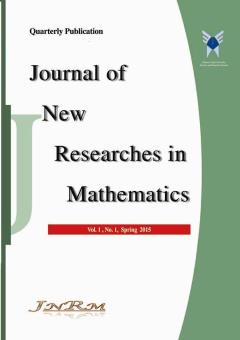A Terminal Fuzzy Sliding Mode Control for Nonlinear leader-follower Multi-agent Systems
Subject Areas : StatisticsNegar Izadi 1 * , Mohammad Taghi Dastjerdi 2
1 - گروه ریاضی، دانشکده علوم، دانشگاه زنجان، زنجان، ایران
2 - گروه ریاضی، دانشکده علوم، دانشگاه زنجان، زنجان، ایران
Keywords: کنترل مد لغزشی ترمینال, سیستم چند عاملی, اجماع, کنترلکننده فازی,
Abstract :
In this article, we present a terminal fuzzy sliding mode controller (TFSMC) for second order nonlinear uncertain leader follower multi agent systems. First, we propose a terminal sliding mode controller that is not only fast and non-singular, but also has a finite time condition in the reaching and sliding phases. Then, in order to eliminate chattering phenomena, a fuzzy sliding mode method is proposed and the stability of the closed-loop system in the lyapunove sense has been guaranteed. According to the communication graph topology and the Lyapunov stability condition, the proposed fuzzy terminal sliding mode controller satisfies the consensus condition in second-order nonlinear multiagent leader-follower systems. One of the main advantages of the controller presented in this article is that even if the initial error value is large, the system will reach equilibrium in a short period of time on the sliding surface. Finally, the advantages of the proposed theoretical approach are illustrated by the simulation results.
[1] G. Antonelli, “Interconnected dynamic systems: An overview on distributed control, “ IEEE Control Systems Magazine. Vol. 33, no. 1, pp. 76–88, 2013.
[2] Y. Cao, W. Yu, W. Ren, and G. Chen “An overview of recent progress in the study of distributed multi-agent coordination.,” EEE Transactions on Industrial Informatics. Vol. 9, no. 1, pp. 427–438, 2013.
[3] J.Y. Hung, W. Gao, and J.C. Hung, “Variable structure control: a survey,” IEEE Transactions on Industrial Electronics, vol. 40, no. 1, pp. 2–22, 1993.
[4] S. Mobayen, V. Johari Majd, and M. Sojoodi, “An lmi-based composite nonlinear feedback terminal sliding-mode controller design for disturbed mimo systems,” Math. Comput. Simul, vol. 85, no. 110, pp. 1–10, 2012.
[5] V. Utkin, “Variable structure systems with sliding modes,” IEEE Transactions on Automatic Control, vol. 22 , no. 2, pp. 212–222, 1977.
[6] S. T. Venkataraman and S. Gulati, “Control of nonlinear systems using terminal sliding modes,” In 1992 American Control Conference. No. 115, pp. 554–560, 1992.
[7] C.W. Tao, J.S. Taur, and M.L. Chan, “Adaptive fuzzy terminal sliding mode controller for linear systems with mismatched time-varying uncertainties,” Cybernetics, vol. 34, no. 1, pp. 255—262, 2004.
[8] K.B. Park and T. Tsuji “Terminal sliding mode control of second-order nonlinear uncertain systems,” International Journal of Robust and Nonlinear Control, vol. 9, no. 11, pp. 769–780, 1999.
[9] M. M. Gulzar, S. T. Hussain Rizvi, M. Yaqoob Javed, U. Munir and H. Asif, “Multi-agent cooperative control consensus: A comparative review,” Electronics. Vol. 7, no. 2, 2018.
[10] R.A. DeCarlo, S.H. Zak, and G.P. Matthews, “Variable structure control of nonlinear multivariable systems: a tutorial,” Proceedings of the IEEE. Vol. 76, no. 3, pp. 212—232, 1988.
[11] C. Edwards and S. Spurgeon, “Sliding Mode Control: Theory And Applications,” CRC Press, London, 1998.
[12] W. Ren and R. W. Beard, Distributed Consensus in Multi-Vehicle Cooperative Control: Theory and Applications, Springer Publishing Company, Incorporated, 1st edition, 2007.
[13] Y. Wu, B. Hu, and Z.H. Guan, “Consensus problems over cooperation-competition random switching networks with noisy channels,” IEEE transactions on neural networks and learning systems, vol. 30, no. 1,pp. 35–43, 2018.
[14] A. Jadbabaie, J. Lin, and A.S. Morse, “Coordination of groups of mobile autonomous agents using nearest neighbor rules,” Automatic Control, IEEE Transactions, vol. 48, no. 6, pp. 988—1001, 2003.
[15] R. Olfati-Saber and R.M. Murray, “Consensus problems in networks of agents with switching topology and time-delays,” IEEE Transactions on Automatic Control, vol. 49, no. 9, pp. 1520 –1533, 2004.
[16] F.L. Lewis, H. Zhang, K. Hengster-Movric, and A. Das. “Cooperative control of multi-agent systems: optimal and adaptive design approaches,” Springer Science & Business Media, 2013.
[17] Y. Zheng, J. Ma, and L. Wang, “Consensus of hybrid multi-agent systems,” IEEE Transactions on Neural Networks and Learning Systems, vol. 29, no. 4, 1359–1365, 2018.
[18] Y. Zheng, Q. Zhao, J. Ma, and L. Wang, “Second-order consensus of hybrid multi-agent systems,” Systems & Control Letters, vol. 125, pp. 51–58, 2019.
[19] K-Y. Zhuang, K-Q. Zhang and H-Y. Su, “Terminal sliding mode control for high-order nonlinear dynamic systems,” Journal-Zhejiang University Engineering Science , vol. 36, no. 5, pp. 482-485, 2002.
[20] y. Feng, X. yu and Z. Man, “Non-singular terminal sliding mode control of rigid manipulators,” Automatica, vol. 38, pp. 2159 –2167, 2002.
[21] Y.J. Mon, “Terminal sliding mode fuzzy-pdc control for nonlinear systems,” Int. J. Sci. Technol. Res, vol. 2, no. 4, pp. 218—221, 2013.
[22] M. Zhihong and X. H. Yu, “Terminal sliding mode control of mimo linear systems”, IEEE Transactions on Circuits and Systems I: Fundamental Theory and Applications, vol. 44, no. 11, pp. 1065–1070, 1997.

